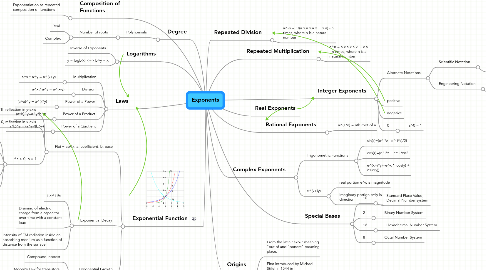
1. Degree
1.1. Polynomials
1.1.1. Number of roots
1.1.1.1. Real
1.1.1.2. Complex
2. Logarithms
2.1. Inverse of Exponents
2.2. y = logb(x) <=> b^y = x
3. Laws
3.1. Multiplication
3.1.1. a^x * a^y = a^(x+y)
3.2. Division
3.2.1. a^x / a^y = a^(x-y)
3.3. Power of a Power
3.3.1. (a^x)^y = a^(x*y)
3.4. Power of a Product
3.4.1. (a*b)^y=a^y*b^y
3.5. Power of a Quotient
3.5.1. (a/b)^y = (a^y)/(b^y)
4. Exponential Function
4.1. F(x) = ab^x, a: coefficient, b: base
4.1.1. b < |1|, reflection in y-axis
4.1.2. a < 0, reflection in x-axis
4.1.3. if a > 0, b > 1
4.1.3.1. Domain : x e R
4.1.3.2. Range : y > 0 , y e R
4.1.3.3. No x-intercepts
4.1.3.4. y intercept at (0,1)
4.1.3.5. Asymptote @ y = 0
4.2. Exponential Decay
4.2.1. Half-Life
4.2.2. Draining of electric charge from a capacitor over time with a constant load
4.2.3. Intensity of EM radiation inside an absorbing medium as a function of distance from the surface
4.3. Exponential Growth
4.3.1. Compound Interest
4.3.2. Moore's Law for transistors
4.3.3. Nuclear Reaction
5. Composition of Functions
5.1. Exponentiation as repeated composition of functions
6. Repeated Multiplication
6.1. a^n = a x a x a x ... x a - n times, where n is a natural number
7. Integer Exponents
7.1. Alternate Notations
7.1.1. Scientific Notation
7.1.1.1. Must have exactly one significant digit before the decimal
7.1.2. Engineering Notation
7.1.2.1. exponents for the powers of ten are multiples of 3 to coincide with the metric prefixes
7.2. positive
7.3. negative
7.4. 0
7.4.1. a^0 = 1
8. Rational Exponents
8.1. a^(1/n) = nth root of a
9. Complex Exponents
9.1. Trigonometric Functions
9.1.1. sin(z)=(e^i*z - e^-i*z)/2i
9.1.2. cos(z)=)e^i*z + e^-i*z)/2
9.1.3. e^(x+i*y)=e^x * (cos(y) + i*sin(y))
9.2. e^(x+iy)
9.2.1. real portion e^x is magnitude
9.2.2. imaginary portion e^iy is direction
10. Repeated Division
10.1. a^-n = 1/(a x a x a x ... x a) - n times, where n is a natural number
11. Origins
11.1. From the latin "exo-" meaning "out of and "ponere" meaning place.
11.2. First introduced by Michael Stifel in 1544 in "Arithmetica Integra" mentioning that "3 is the exponent of 8 and 5 is the exponent of 32"
12. Real Exponents
13. Special Bases
13.1. 10
13.1.1. Standard Place Value; Decimal Number system
13.2. 2
13.2.1. Binary Number System
13.3. 16
13.3.1. Hexadecimal Number System
13.4. 8
13.4.1. Octal Number System
